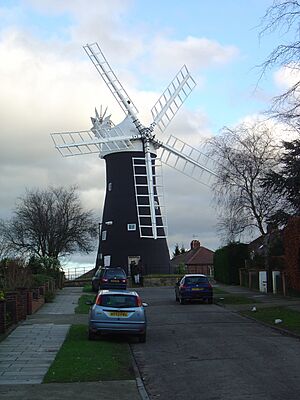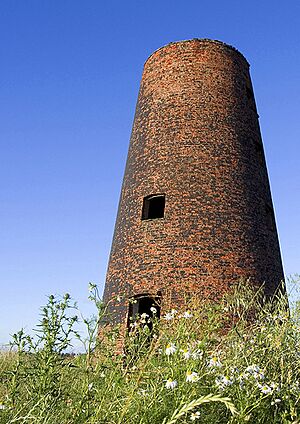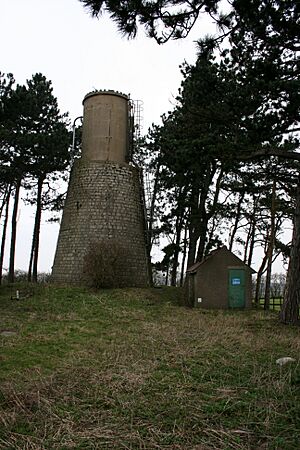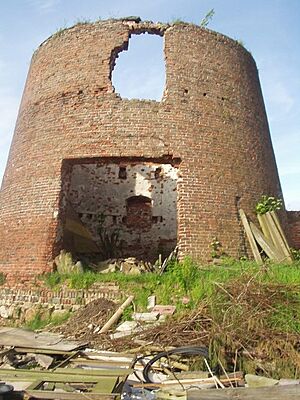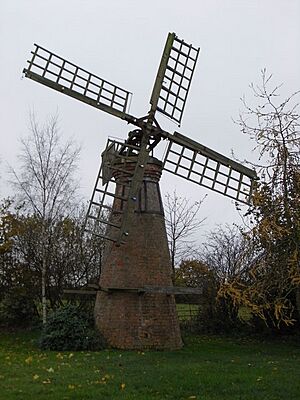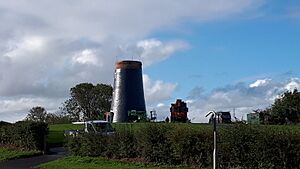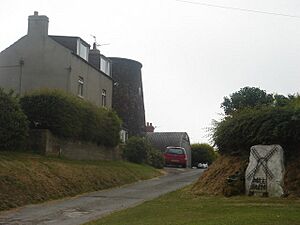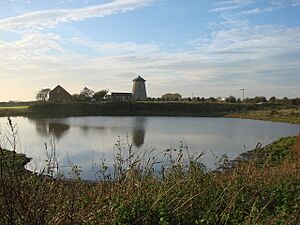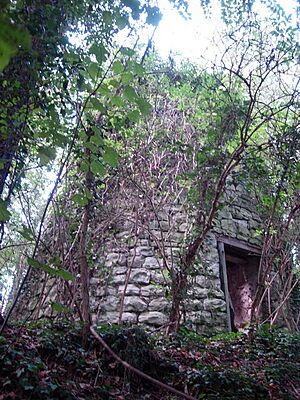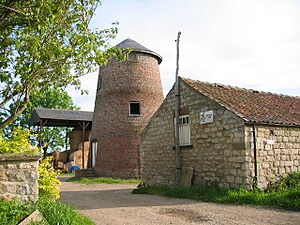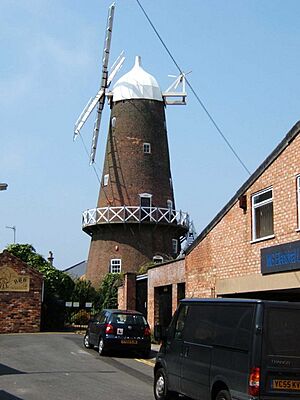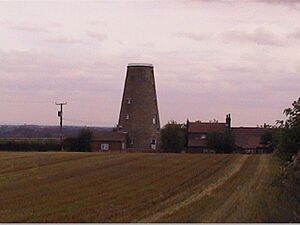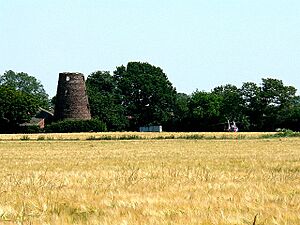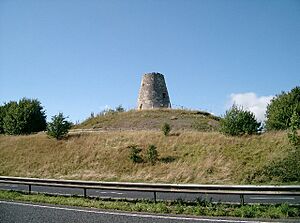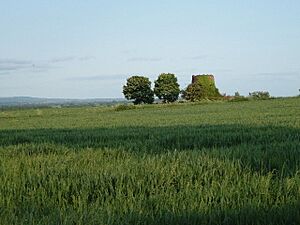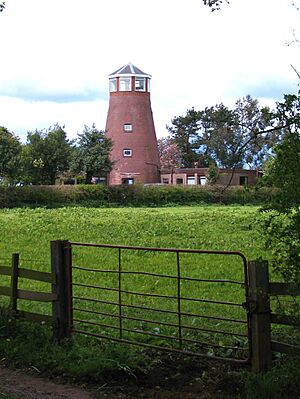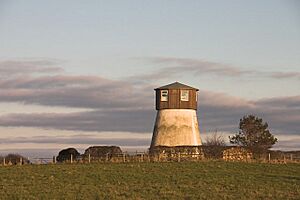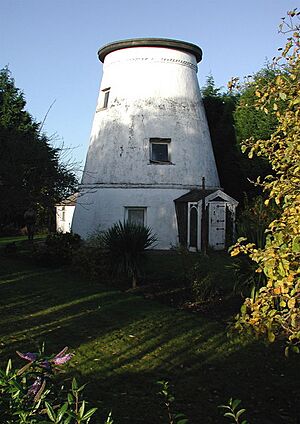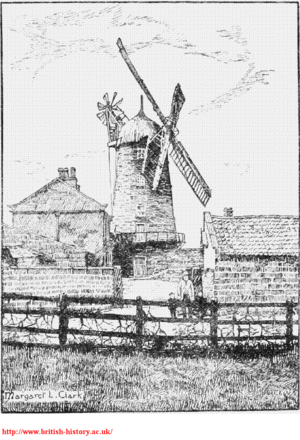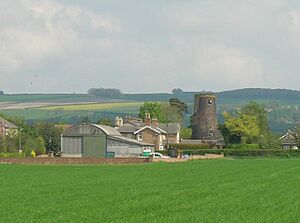List of windmills in North Yorkshire facts for kids
Windmills are amazing buildings that use the power of wind to do work, like grinding grain into flour or pumping water. For hundreds of years, they were super important for communities, helping people make food and manage water. In the English county of North Yorkshire, you can find many windmills, both old ones that are no longer working and some that have been saved and restored. This list explores some of these fascinating structures, showing where they were located and what type they were.
Contents
Windmills in York City
The city of York has a long history with windmills. Many of these mills were used for grinding corn or other tasks. Some of them date back many centuries, showing how important they were to the city's daily life.
Famous York Windmills
- Holgate Windmill: This is a famous tower mill in York. It was built a long time ago and is a great example of how windmills looked. Today, it's one of the few working windmills left in the area.
Other Mills in York's Past
Many other windmills once stood in different parts of York. They had interesting names like Clifton Mill, Pepper Mill, and Bootham Stray Mill. Some were post mills, which are older types of windmills where the whole body of the mill turns on a central post. Others were smock mills or tower mills, which are usually taller and only their top part (the cap) turns to face the wind.
- Clifton Mill: There were a few mills known as Clifton Mill or Lady Mill, mentioned as early as 1374. They were important for the area for many years.
- Bootham Stray Mill: This was a post mill first mentioned in 1772. It was later taken down around 1840.
- Holgate Mill: An older mill with this name existed between 1366 and 1433, long before the famous Holgate Windmill we know today.
- York Field Mills: This area had different types of mills over time, including a post mill built around 1620 and a smock mill from 1783.
- Clementhorpe Mills: This area near the River Ouse also had windmills, with some dating back to the early 16th century. One was called Nun Mill.
Windmills Across North Yorkshire
Beyond York, many other towns and villages in North Yorkshire also had windmills. These mills played a vital role in the countryside, helping farmers and local communities.
Notable Mills in Other Locations
- Appleton Roebuck Mill: This is a tower mill that dates back to the early 19th century.
- Askham Richard Mill: Another tower mill that stands in Askham Richard.
- Brompton Mill: This tower mill in Brompton was still standing in 1914.
- Elvington Windpump: Located in Elvington, this is a tower mill that was likely used for pumping water, perhaps for a brickyard.
- Muston Mill: Found near Filey, this tower mill is now truncated, meaning its top part has been removed.
- Low Hawsker Mill: This tower mill near Hawsker was still standing in 1923.
- Kellington Windmill: This mill in Kellington was still standing in 1923. It has since been converted into a house.
- Huddleston Mill: A tower mill located in Huddleston.
- Malton Mill: This tower mill stands in Malton.
- Peak Mill: A tower mill near Ravenscar.
- Riccall Mill: This tower mill is located in Riccall.
- Victoria Mill: A tower mill in Scarborough.
- Kirby Mill: This tower mill is in Skelton-on-Ure.
- South Duffield Mill: A tower mill in South Duffield.
- Stutton Mill: This tower mill is located in Stutton.
- Thornton Mill: A tower mill in Thornton-le-Clay.
- Tollerton Mill: This tower mill is found in Tollerton.
- Ugthorpe Mill: A tower mill in Ugthorpe.
- Ulleskelf Mill: This tower mill is located in Ulleskelf.
- Newholm Mill: A tower mill near Whitby.
- Yapham Mill: This tower mill in Yapham was built in 1805.
Other Historical Windmills
Many other places in North Yorkshire also had windmills, even if they are no longer standing today. These include:
- Acklam (1582-1613)
- Aldborough (had both post mill and tower mill types)
- Alne (1575)
- Barlby (had both post mill and tower mill types)
- Bossall (1830)
- Cayton (Cayton Cliff Mill, 1661)
- Claxton (Claxton Mill, a tower mill, and a brickworks tower mill)
- Coatham (Station Road Mill, a tower mill, standing during World War I)
- Cundall (Staynhill, 1341)
- Danby Wiske (1285)
- Dromonby (1583-1671)
- Dunnington (1295)
- Earswick (1323)
- Escrick (1290)
- Farlington (1588)
- Flaxton (1590)
- Follifoot (Follifoot mill, a tower mill)
- Fylingdales (Peak Mill, standing in 1923)
- Guisborough (1540)
- Helperthorpe (a sunk post mill)
- Heslington (Stublowe Myln, 1530; also had a post mill and a tower mill)
- Holtby (1571-1616)
- Hornby (Hornby Mill, a tower mill)
- Hemlington (1352)
- Hunmanby (1298, and another in 1732)
- Huntington (1322-1460)
- Kirk Leavington (1262-1315)
- Kirkbymoorside (Kirkbymoorside Mill, a tower mill)
- Kirkleatham (1340)
- Little Smeaton (Little Smeaton Mill, a post mill, demolished in 1961)
- Malton (Malton Mill, a tower mill)
- Marske (1349-1560; West Field mills from 13th century and 1609)
- Marton (14th century, 16th century, and 1834-1865)
- Northallerton (Northallerton Junction, standing in 1914)
- Ormesby (possibly 12th century)
- Overton (1629-1664)
- Pateley Bridge (Pateley Bridge Mill, a tower mill)
- Pickering (a tower mill, 1841)
- Picton (1566-1657)
- Redcar (Redcar Windmill, a tower mill, 1836-1859)
- Riccall (1295)
- Rillington (a sunk post mill)
- Romanby (1663)
- Sand Hutton (The Moor, 1604)
- Scarborough (1340, 1641)
- Sillington (1295)
- Sitlington (Sandy Lane Mill, a tower mill)
- Skirlaugh (Swine Priory, 1560s-1611)
- Snainton (Foulbridge, 1273-1307)
- Stainton (1591)
- Stillington (1244)
- Stittenham (1633-1808)
- Thornaby-on-Tees (1575-1625)
- Tollerton (Tollerton mill, a tower mill)
- West Coatham (1367)
- Warrenby (Marsh House Farm, destroyed by fire in 1815)
- West Rounton (17th century)
- Whitby (East Cliff, 1540; Union Mill/Co-operative Mill, a tower mill, 1806-1923; Wren's Mill, demolished 1862)
- Yarm (1272-1354; 1608-1614; and one standing in 1923)
Maps Showing Windmills
Old maps can tell us a lot about where windmills used to be. Some important maps that show windmills in North Yorkshire include:
- 1772 T Jeffereys
- 1775 Jackson
- 1829 A Bryant
- 1855 Ordnance Survey


